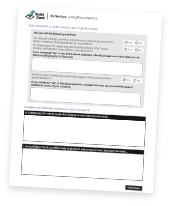Strategy: Using Precorrection
Check-Up Menu > Using Precorrection
How To
How to Use Precorrection in Your Classroom
Examples:
- Walking in the hallway
- Transitioning from seats to rug
- Fire drills
- Assemblies
- Morning or end of day routines
Next, develop a concise statement that explicitly states what the students should do immediately following the precorrection (e.g., “We are about to go to lunch. So, I need each of you to put your books in your desk, stand up and push in your chair, and then walk quietly to line up at the door. Ready? Begin.”).
Finally, provide a lot of behavior-specific praise to students who meet expectations. Determine what percentage of students met the expectation. If less than 85% of the class are able to follow your precorrection, consider taking time to re-teach the expectation (see Teaching Behavior Expectations). If only one or two students continue to struggle, you may want to provide them with individualized and private precorrections to help them be more successful.
It is good to increase the use of precorrection when there are breaks from school (e.g., winter break, many snow days, etc.) or if a substitute has been in your classroom.
Video Prompts:
- This teacher has already taught her students to use a number system to monitor the level of sound they should be using during an activity.
- In this video, as she is passing out an assignment, she provides a precorrection to a make sure the students use the appropriate level of their voice (“Level 1, no more than 2”).
- How might giving this prompt prevent students from inadvertently being too loud during the assignment?
- What did you like about how the teacher helped the students determine what level of sound was appropriate?
- What activities or times of the day would it be useful to provide your students with a precorrection so that students know what to do before problems occur?
Strategy Tool

Reflection

Goal Setting

References to Other Relevant Resources:
Reinke, W., Herman, K., & Sprick, R. (2011). Motivational interviewing for effective classroom management: The classroom check-up. New York, NY: Guilford Press.
Stormont, M., & Thomas, C. N. (2014). A general educator’s guide for working with students at risk for failure. Thousand Oaks, CA: Corwin Press.
Stormont, M., Reinke, W., Herman, K., & Lembke, E. (2012). Tier two interventions: Academic and behavior supports for students at risk for failure. New York, NY: Guilford Press.
Stormont, M., & Reinke, W.M. (2009). The importance of precorrective statements and behavior-specific praise and strategies to increase their use. Beyond Behavior, 18, 26-32.
Stormont, M., Lewis, T. J., Beckner, R., Johnson, N. W. (2008). Implementing systems of positive behavior support systems in early childhood and elementary settings. Thousand Oaks, CA: Corwin Press.